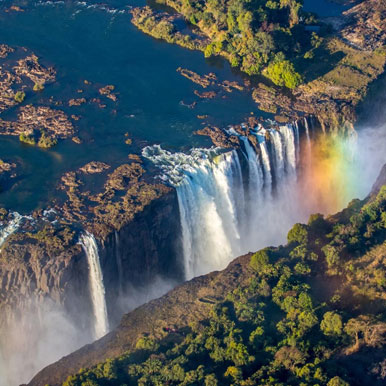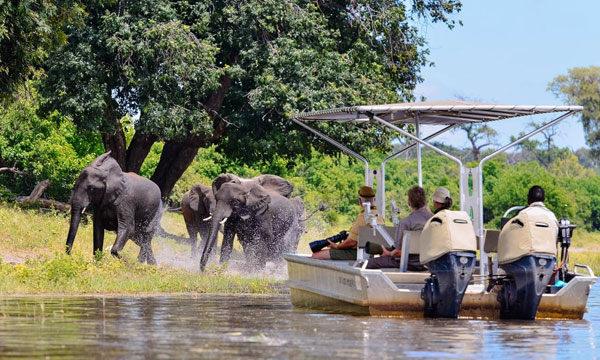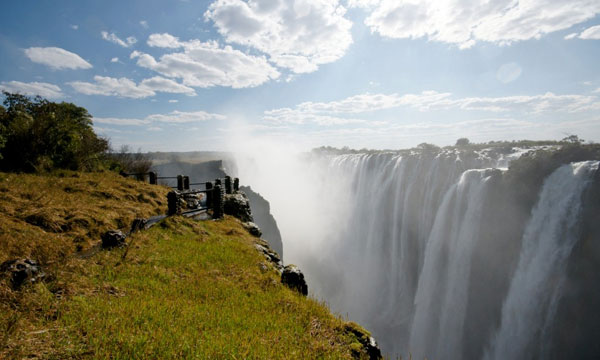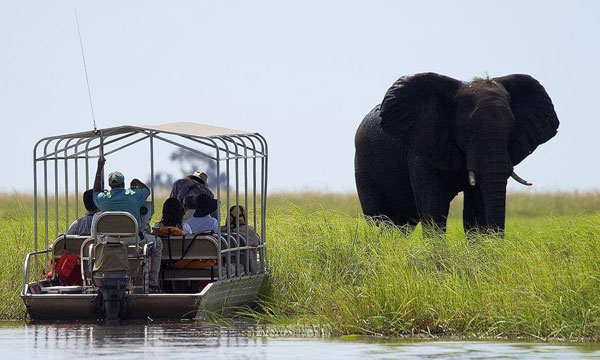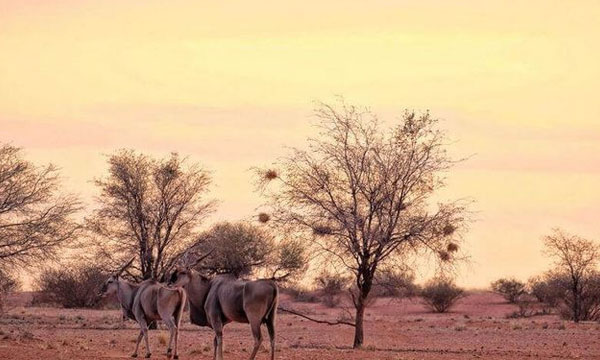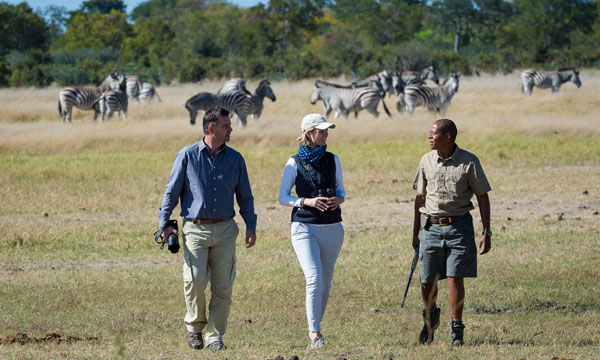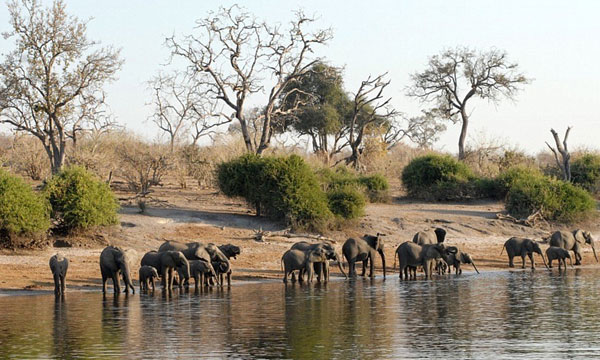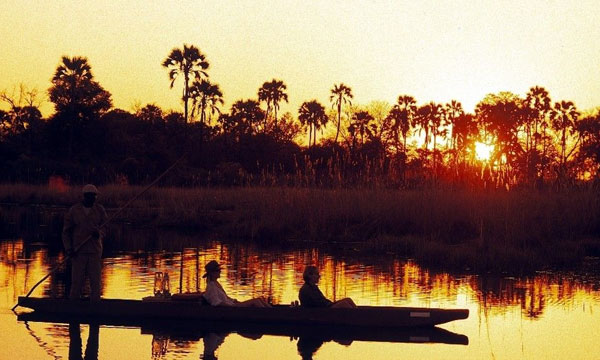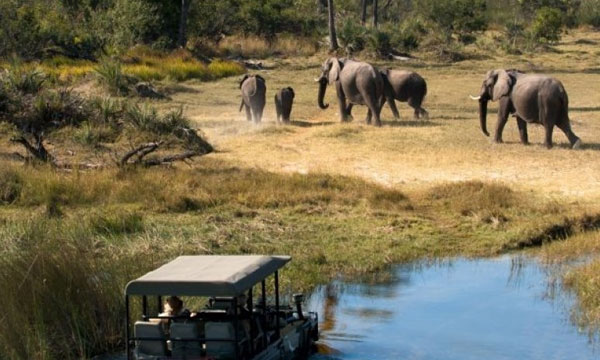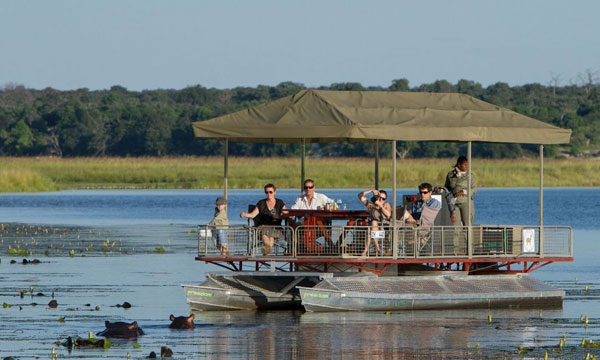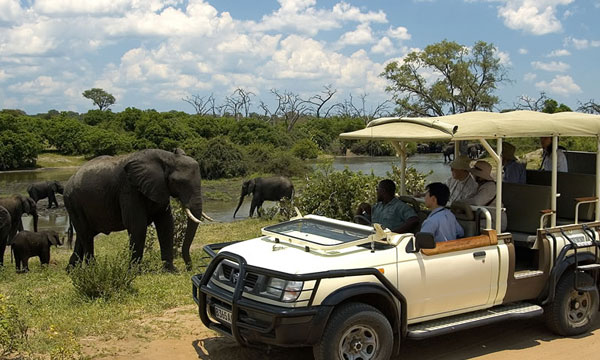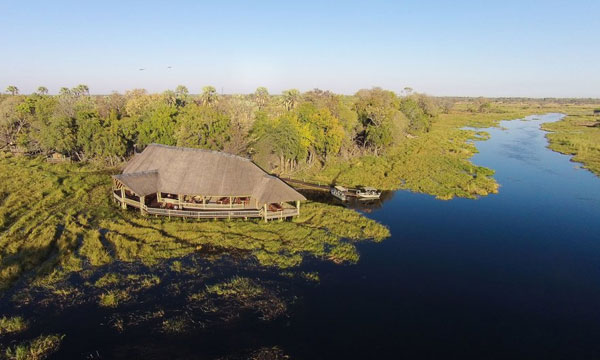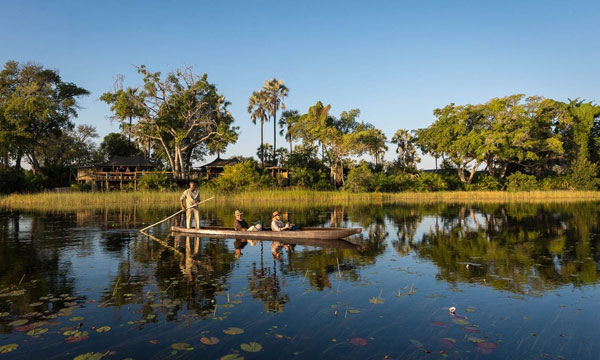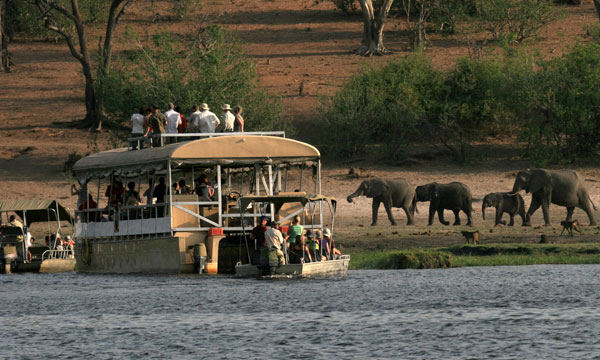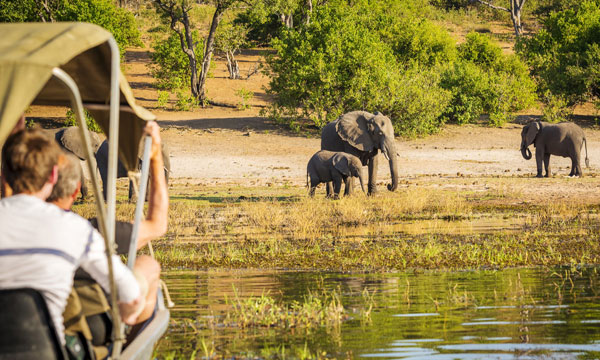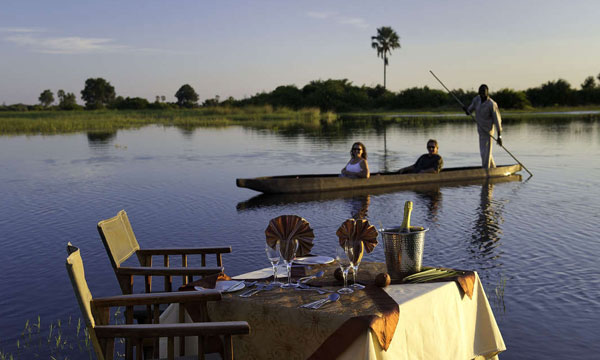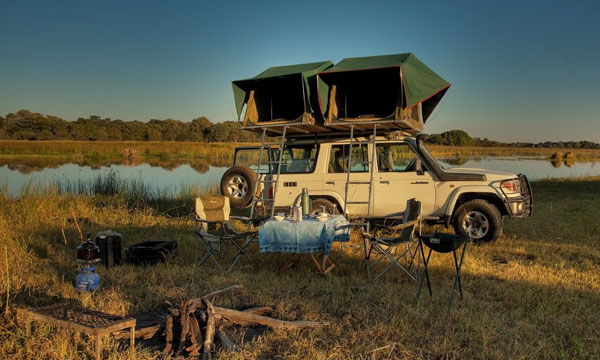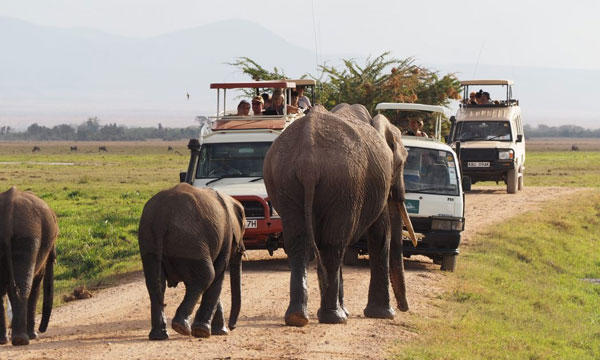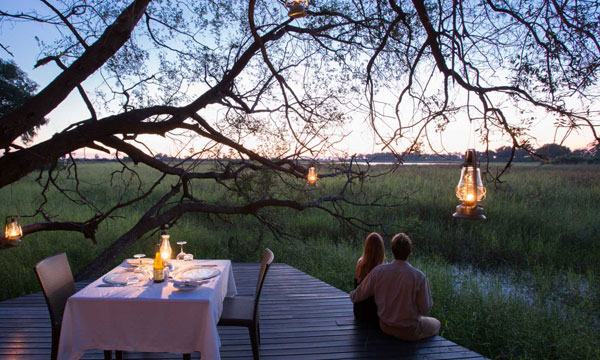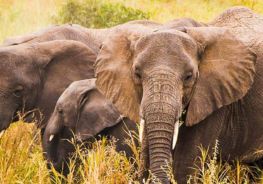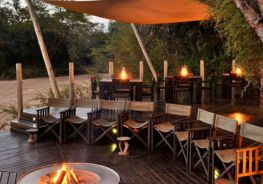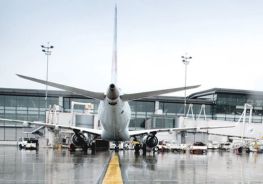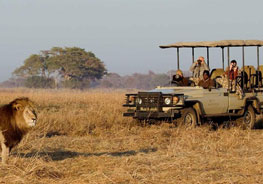Call Us
8:00am - 17:00PM
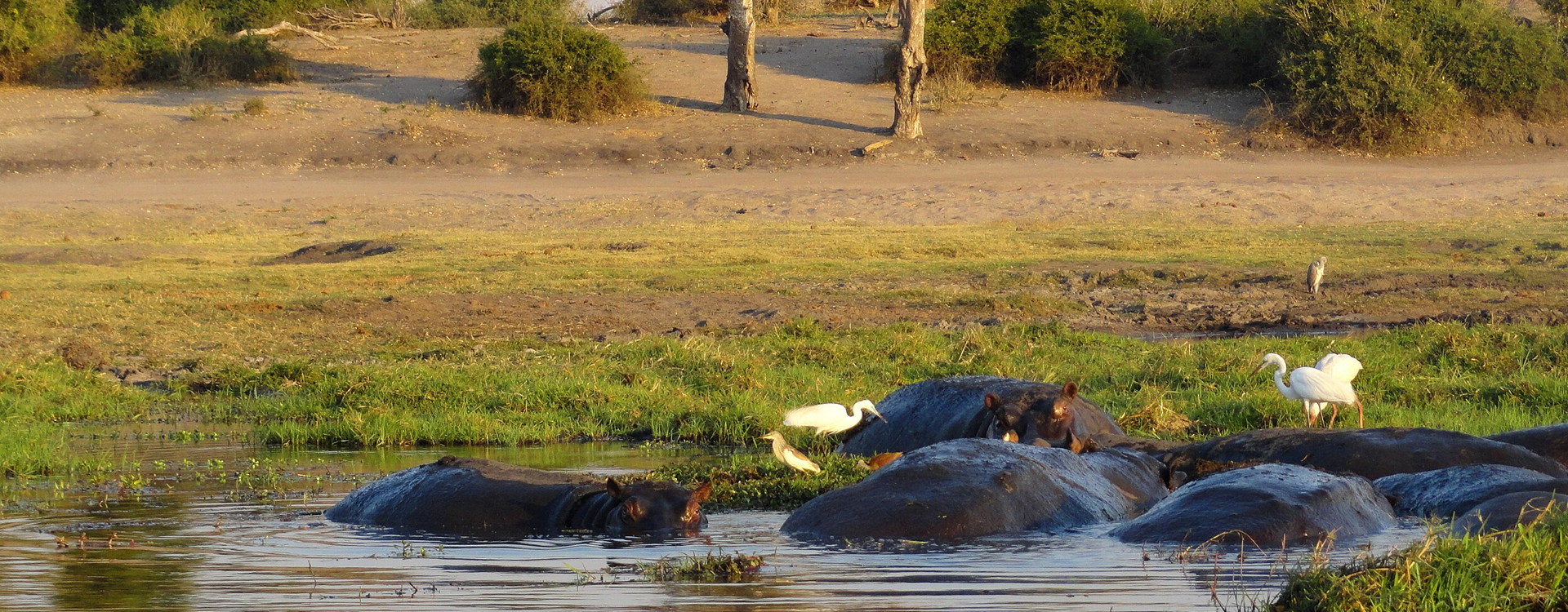
Chobe National Park
About Chobe National Park
Chobe National Park is one of the greatest wildlife destinations you can ever visit in Botswana. It is considered to have one of the largest concentrations of game in Africa. Its vegetation is lush, dense and it consists of many different smaller ecosystems. If there is one thing you should know about Chobe is that it is the land of the giants, boats of having a large elephant population.
Chobe National Park Tours and Safaris
We Think You’ll Love
Best Time to Visit Chobe National Park
The Best Time To Visit Chobe National Park is between May and October when you can see lots of wildlife. This period is great for watching big groups of elephants and buffaloes in the riverfront area and the Savuti region. Early in the season from May to July, it's cooler, especially at night. But it gets really hot from August to October, making for amazing animal sightings despite the heat. All year round, Chobe National Park Safari provides fantastic experiences, showcasing different scenes and animal activities with the changing seasons.
Chobe National Park Wildlife
Chobe National Park is a hub of wildlife, featuring elephants and buffalo along the riverbanks during dry seasons. Zebras, puku, and impala are commonly seen, with greater kudu and sable antelope more hidden. Lions are a common sight, and you might even see wild dogs. At sunset, the floodplains offer stunning views, including smaller species like the Chobe bushbuck and red lechwes, alongside small predators, highlighting the diverse ecosystem of Chobe National Park Wildlife
What To Experience
We Think You’ll Love
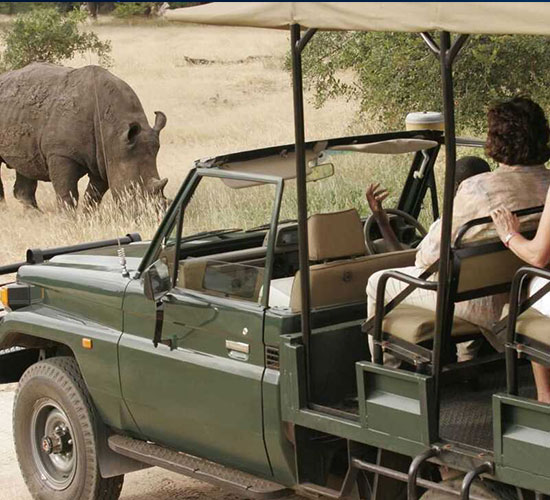
Game Drives
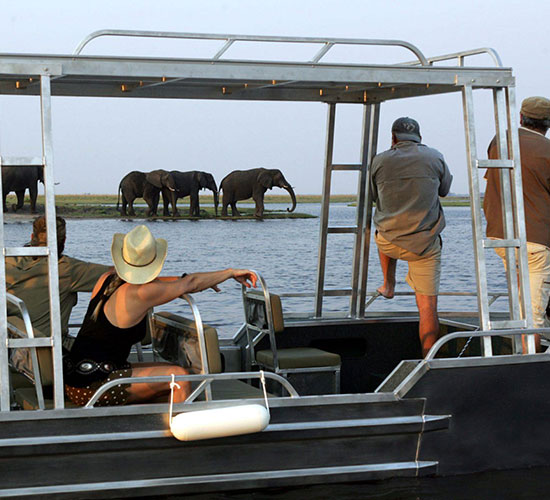
Boat Cruises
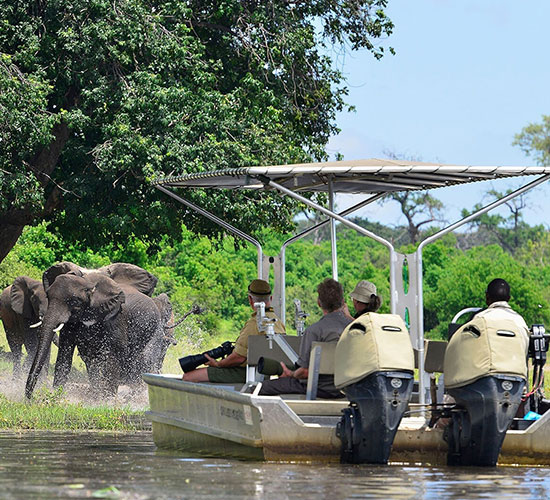
Photographic Safaris
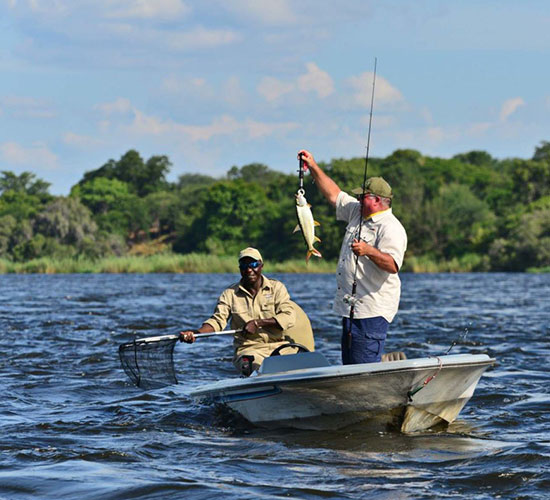
Fishing
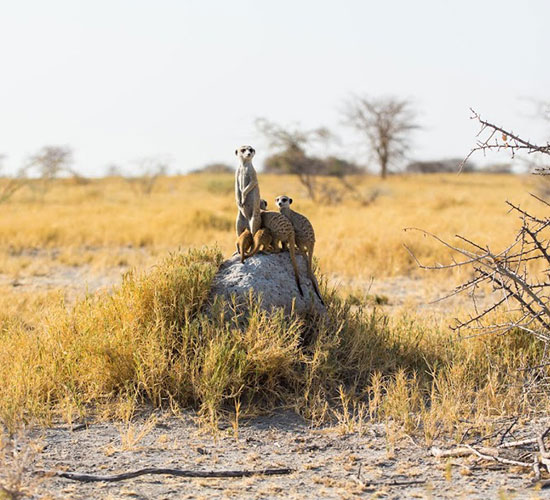
Guided Bush Walks

Village Tours
Travel Guide For Chobe National Park
We Think You’ll Love
Map of Chobe National Park
Chobe National Park is located in the Northern part of Botswana and it expands across an area of 11 700 square km. This makes it the third largest park in the country after the Central Kalahari Game Reserve and the Gemsbok National Park. It is a GANP Ambassador park. The park can be divided into 4 different areas, The Chobe Riverfront, The Savuti Marsh area, Linyati Marsh, and Nogatsaa (each with different ecosystems).
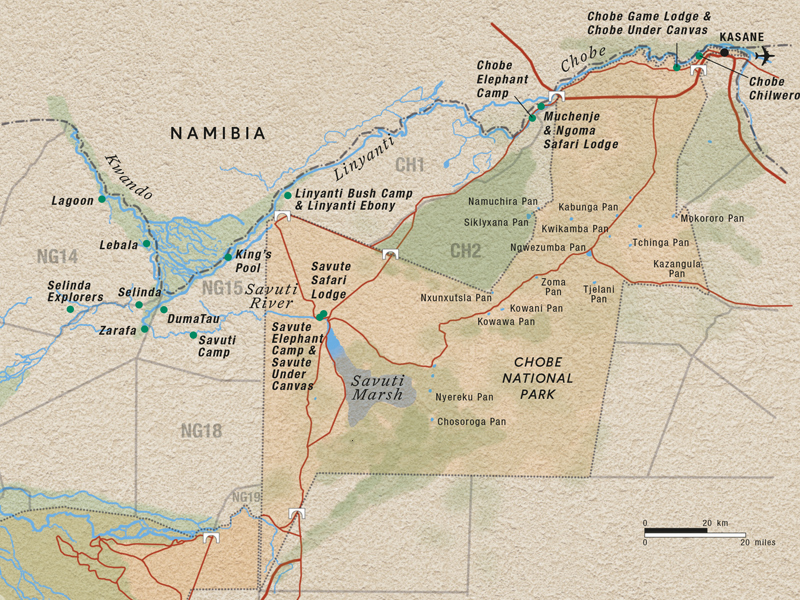
Going On A Chobe National Park Safari
Going on a Safari In Chobe National Park is like going to a wildlife haven. You will feast your eyes on the beauty of nature and appreciate the diversity in ecosystems. Your guide will be there every step of the way to explain in detail about the area and its wildlife. Your Botswana Safari might look something like this; you will drive for a few metres along the impressive Chobe Riverfront. An elephant family slowly walks across the road, intending to bathe.
You can hear the dull sound of heavy feet in the sand, breathing and whiffing, and occasional trumpeting from these beautiful, mighty creatures as you gaze at this amazing scene. The up-close and personal encounters with wildlife at Chobe National Park are among the most awe-inspiring safari experiences, and we can assure you that you will have many of them during your visit. Welcome to the park with some of Africa's highest game density.
Getting To Chobe National Park
There are several different ways that you can use to get to Chobe. The park has such a strategic location, close to several borders making it easily accessible from Zimbabwe, Zambia as well as from Botswana.
Getting To Chobe From Zambia
Livingstone is linked to the ferry at the Kazungula border by the M10 road. You can use this and then drive 80km into Chobe.
Getting to Chobe from Zimbabwe
The easiest way to Chobe from Zimbabwe is to use the A33 road that passes through Zambezi National Park from Chobe National Park on its way to Kasane in Botswana.
Getting to Chobe from Kasane
You can enter Chobe through several gates; there is Sedudu Gate near Kasane, the Ngoma Gate near Namibia and The Mababe Gate to the south that ultimately connects Chobe with the Moremi Game Reserve.
Weather & Climate In Chobe National Park
Chobe has a warm to hot climate, and it is characterised by a Dry and Wet season. The Dry season months run from May to August and are the coolest. The wet season runs from November to March and is the warmest season. Rainfall is highest between December and March. The average daily temperatures in the Dry season start at 30°C in April and by October they’ll be at a very hot 35°C. In the Wet season it can get extremely hot and temperatures can reach 40°C resulting in the heavy storms of January and February.
The last rainfall showers that mark the end of the Wet season usually fall in April. From May, the park becomes very dry. In June and July, the park experiences cool weather, the coolest all year round. Temperatures however begin increasing in August and are at their peak in October.
Best Time To Visit Chobe National Park
When choosing the Best Time To Visit Chobe National Park, it is important to consider the seasons and what to expect at that time. It is nearly impossible to choose between the two seasons however because Chobe deserves to be visited during both. Summer "green season" birding is at its best, and the area is at its most lush and beautiful. This is also the time of year when the Savute zebra migrates. In contrast, the dry season is notable for its elephant population.
Chobe National Park is open all year. The park's wildlife migrates with the seasons. The riverfront area is best explored during the dry season, which runs from May to October. The months of August to October are ideal for wildlife viewing here, but they are extremely hot. Many animals, particularly plains zebras, migrate to the Savute Marsh during the wet months, while Linyanti is best toured from April onwards.
Quick Chobe Safari Facts
- Chobe is home to the largest population of elephants in the world, they are over 120 000.
- Some of the best safari boat cruises in the world are experienced on the Chobe River.
- Chobe has about the largest concentrations of game in all of Africa.
- Chobe is a top-class bird-watching area as it has over 450 species of birds.
- The Savuti area is one of the best places in Africa to see vigorous predator action.<
Quick Chobe Safari Facts
What Does A Chobe National Park Safari Cost?
The more money you have, the more private and exclusive your safari can be. Aside from personalised service and luxurious accommodations, the best advantage of staying in a private concession is the quality of game viewing available (not of the wildlife but of the actual experience).
During peak safari season (roughly July to October), Chobe National Park can become extremely crowded, and you'll most likely share animal sightings with other vehicles and groups, including self-drivers and day-trippers. A private safari includes a private guide, vehicle, and a slice of pristine wilderness to explore and although might be a bit expensive, is very worth it.
Chobe Safari, Africa’s Elephant Paradise
Chobe National Park is the world's elephant capital, with over 120,000 elephants roaming the park. With Chobe you are guaranteed to see elephants. The Kalahari elephant is the largest species of elephant, but its tusks are relatively short. Visitors will be able to see the elephants from the water as well as on land.
When visitors arrive in Chobe, they will be ecstatic to see their first herd of elephants. By the end of the day, the typical response is, "Oh, more elephants." The excitement for elephant sightings fades as the day progresses because there are so many of them. Elephant sightings in Chobe National Park are the closest thing Africa has to a guarantee of wildlife sightings. There are so many elephants in the area because of the amount of shade as well as the availability of food and water.
Abundant Wildlife & Birdlife
Chobe National Park has one of the highest concentrations of wildlife on the continent. Bird-watching enthusiasts will appreciate the opportunities that Chobe safaris provide. While heading down the Chobe River and along its banks, you can see a variety of bird species such as the Fish Eagle, Martial Eagle, Kingfisher, Pel's Fishing Owl, and many others. Egyptian geese, Sacred Ibis, and all rollers are among the other bird species. Lions can be found hunting elephants in Chobe National Park. They usually target young or tired elephants, but it is more popular in Chobe than in most other African national parks.
You can also see all the animals in the big 5. The Park also provides unique water-based game viewing. You will get the incredible opportunity to see elephant herds swimming across the river, crocodiles sunbathing and hippos opening their mouths up to 150 degrees. You will also encounter zebras, impala, giraffes, sable, Bat-eared foxes, waterbuck, puku and wild dogs.
Activities In Chobe National Park
There is so much you can do in Chobe, its dramatic, diverse landscapes and untamed wildlife can be explored in many different ways. You can explore on foot, by vehicle or by boat. For some, self-drive is the best option whereas to some having an experienced guide adds rich layers of detail and interpretation into the safari.
Game Drives
This is the most popular way to experience Chobe. Nothing gives more thrills than spotting game as you drive along the park. You can either do a game drive in your own vehicle or on a guided safari.
Boat Cruises
The Chobe River is a beautiful place to cruise along as you view wildlife that is common on the river banks. The river is the source of life to many animals that live in the Park so you are always in for a beautiful wildlife sighting. The most common animals you will see are the herds of elephants splashing their way across the river, crocodiles, hippos and you can hear calls of the African fish eagles.
Fishing
For those who love fishing then Chobe has you covered. You can go fishing whilst you visit Chobe.
Photographic Safaris
For those who love exploring and adventure mixed with photography then this might be a perfect opportunity for you. You will get the opportunity to capture wildlife and the beautiful scenery of Chobe with professional wildlife photographers.
Mobile Safaris
A mobile safari ticks all the boxes for the ultimate adventure holiday. Small camps in the remote areas provide the best wilderness experiences. On a mobile safari, you move with your camp and staff to pristine locations.
Chobe National Park Day Trip
Whilst you are in Chobe, you can choose to cross into Zimbabwe or Zambia to see the Chobe National Park. This is good as you can combine Vic Falls with your Chobe Safari Trip because it will be nearby.
Chobe National Park Accommodation
Chobe National Park has some of the best lodges and camps in the country and we recommend you stay at some of the few listed below.
Chobe Safari Lodge
Guests at the Chobe Safari Lodge have the opportunity to choose between a numbers of accommodation types. This makes it the best value for money lodge amongst all the lodges in Chobe. There are 22 luxurious River Rooms that overlook the Chobe River. Family Rooms are also available. The River Room complex has a beautiful garden next to the Chobe River and it is connected to the main building at the Chobe Safari Lodge by means of a viewing deck.
Chobe Savanna Lodge
Chobe Savanna Lodge sits on the bank of the Chobe River, right at the northern part of the Chobe National Park. The main emphasis of Chobe Savanna Lodge is to ‘chill down’ and it definitely is suited for that.
Muchenje Safari Lodge
Muchenje Safari Lodge is such a great value lodge. Out of all the Chobe lodges, it has the best views. It is privately-owned and is situated away from the crowds that the Park has become infamous for. The lodge has a great unpretentious safari atmosphere and is more economical than other lodges. Another advantage of Muchenje is that along with all the other activities like boating and game drives, you can do a walking safari and do night drives. This is the only lodge in the park where this is possible.
Chobe Chilwero
Chobe Chilwero is one lodge that provides luxurious accommodation in Chobe. It has great views, excellent service and absolutely beautiful rooms that make this one of the best choices for accommodation. It is beautiful and allows you to experience an epitome of luxury but however this camp is not for the authentic safari lover!.
Chobe Game Lodge
Despite the size of the lodge, there is no comparable experience in Africa. We love this place because of the amazing rooms, facilities, and service, as well as the best views and largest concentrations of game in Botswana. It's ideal for a two or three-night stop before heading off into deeper and more remote camps for the rest of your trip.
Chobe Under Canvas
This camp is run by & beyond, a company that is known for providing some of the best safari products in Africa due to their emphasis on quality food and drink as well as a high standard of guiding. Chobe Under Canvas certainly lives up to its name. Overall, a truly stunning mobile camp that is remarkably well-designed.
What To Pack Before Going On Chobe Safari?
Clothing
To be honest, you don't need a completely new wardrobe for a Chobe safari adventure. Simply leave your brightly colored attire at home and pack lightly. Bring some light fabrics and loose-fitting clothing in soothing colors that dries quickly.Bring a scarf and a warm sweater (or jacket). Temperatures drop in the mornings and evenings, so warm clothing is essential on a game drive. If you're still shivering, camps also offer 'bush babies' (and you will soon find out what those are).
Safari tools
Although Chobe safari lodges usually provide everything you could want, bringing your own tools is both fun and useful. So, what are you going to bring? Here are some things we always pack in our suitcases:
- Binoculars (for viewing animals from your private deck at any time and from any location);
- Of course, your camera!
- A low-cost, waterproof watch (leave expensive jewelry at home)
- Lip balm and sunblock
- A tiny pocket torch
- Repellent for insects
- Water bottles are frequently provided at camps, but you can bring your own.
Best Month to Visit Chobe National Park
We Think You’ll Love
Peak
Low
Mixed
Chobe In January
Chobe National Park is alive with greenery during the Green Season. It's a quiet time and is perfect for enjoying Chobe Safari Activities at lower prices. The park receives more rain, making the riverbeds full and the bush vibrant with new life.
Chobe in February
This month brings spectacular thunderstorms, creating unique experiences during Chobe Safari Packages. These brief storms are followed by clear skies, making it an excellent time for birdwatching, as all migratory species are present. However, there's a higher malaria risk, so precautions are necessary.
chobe in March
In Chobe, March marks the start of autumn and the end of summer rains. The abundant surrounding greenery makes spotting wildlife a delightful challenge, with the landscape at its most lush. This period offers unique opportunities for observing Chobe National Park Wildlife amidst the vibrant foliage, making safaris especially scenic.
Chobe in April
The onset of autumn in April sees wildlife, including elephants and buffaloes, drawn to the Chobe River to satisfy their thirst. The best way to observe these large groups of animals is to take part in Boat Safaris around this time. Also, the drying bush improves visibility for Things To Do In Chobe National Park, as zebra and wildebeests begin their migrations, making it an important month for witnessing wildlife movements
.Chobe in May
May in Chobe is recognized as the Best Time to Visit Chobe National Park, with cooler mornings and the beginning of the dry season. This is the beginning of peak safari season in Chobe and Kasane with lots of tourist activities all around. The park's dynamics change as wildlife concentrates around water sources, significantly enhancing safari experiences and wildlife observation opportunities.
Chobe in June
June is the peak safari season, offering ideal conditions for exploring the park and staying in luxury lodges. Nights can be chilly, with temperatures sometimes falling below zero. It's wise to bring warm clothing for the evenings to stay comfortable while enjoying the park's offerings during this prime wildlife viewing period. With plenty of opportunities for wildlife sightings, June is a prime time for engaging in various Chobe Safari Activities
Chobe in July
Despite being the chilliest month, July sees Chobe alive with wildlife around waterholes. Massive groups of elephants and chances to spot rare wild dogs add excitement to Chobe Safaris. This period highlights the abundance of animals drawn to the Chobe River's banks, offering unique sightings and making it a standout time for experiencing the park's dynamic wildlife scene.
Chobe in August
August continues the dry season, perfect for fishing and observing concentrated animal activities around shrinking water sources. This month is particularly vibrant for safari goers, with activities like the annual barbell run in the Kasai channel, highlighting the rich biodiversity of Chobe.
Chobe in September
In September, spring's warmth returns. This brings the first migratory birds back to the park, making it an excellent period for birdwatching safaris. The changing season offers fresh opportunities for big game sightings in Chobe, with tiger fishing also being popular among visitors.
Chobe in October
As one of the warmest months, wildlife disperses from dwindling water sources, offering a quieter safari experience. This month is ideal for enjoying Chobe National Park Safari with fewer crowds and taking advantage of reduced rates, amidst the dry landscape beginning to anticipate the rains.
Chobe in November
The Chobe Weather is mostly hot and clear, marking the start of the Green Season. The first rains rejuvenate the dry landscape, triggering a flourish of activity among the acacia, baobab, and sausage trees, and initiating the calving season, offering a renewed perspective for Chobe Safari Activities.
Chobe in December
Characterized by hot and humid conditions, December welcomes significant rainfall, setting the stage for the zebra migration through ancient routes from Chobe To The Kalahari. This month transforms the park into a dynamic ecosystem, ripe for exploration and offering a lush backdrop for witnessing the migratory patterns and vibrant life in Chobe.
Related Chobe Travel Guide
We Think You’ll Love
Frequently Asked Questions
We Think You’ll Love
Being home to 120,000 elephants, Chobe National Park holds the highest elephant concentration in Africa. The long stretched landscape and the ample wildlife make Chobe National Park worth visiting. On the banks of the Chobe River, a large number of rhinoceros and hippopotamus can be seen.
Chobe National park is famous for having the largest elephant population in Botswana. It is home to over 120,000 elephants making it one of the spectacular safari destinations. The Chobe National Park is also perfect for birding, and the Chobe River itself is the best place to see wild animals such as rhinoceros and hippopotamus.
Being the first National Park of Botswana, the Chobe National Park offers the best game viewing game experience. The Chobe National Park is famous for having the largest elephant population, more than 120,000. Not only elephants but also the other animals that can be seen here are lions, buffalo, antelopes, and hippos.
Located in the north of Botswana Chobe National Park is a safe place to visit. The closest city to Chobe National Park is Kasane. You can easily get to the Chobe National Park from Kasane Airport, by charter flight.
If have a very limited time, you recommend you spend at least 3 days and 2 nights. During these days you can go for an early morning game drive and a late afternoon game drive. A game drive in Chobe National Park allows you to see its pristine wildlife and nature.
Definitely, Yes. A safari in Chobe National Park takes you on a journey to explore its vast wildlife from a very close distance. You can easily spot the big five during a safari in Chobe National Park. The low-density tourism model means Chobe National Park never gets crowded, which gives you more exclusiveness to the surrounding nature.
$11, for non-citizens it costs 11 USD per person per day. But if you are from Botswana USD 3. The accommodation price may vary between $100 to $1000 depending on the types of lodges or hotels you choose.
Yes, Chobe National Park is eco-friendly and its primary focus is on developing sustainable tourism. The lodges and hotels also follow the same path. Some of the efforts that have been made are the recycling of plastic bottles and glass cans, biogas production, and grey water recycling.
Sure, you can self-drive in Chobe National Park. Chobe National Park is the easiest safari destination in Botswana if you are planning for a self-drive safari. In peak seasons like May to October, it may be not easy to go on a self-drive due to the high number of tourists.
What makes Chobe National Park special is its home to120, 000, elephants and is also known as the elephant capital. Along with this the game viewing experience also makes it the finest safari destination in Africa.
May to October is the best time to visit Chobe National Par. The low rainfall makes the game viewing experience superb. May to October is also the dry month in Chobe National Park. This is also the peak season which means more visitors.
We are thrilled to help you plan your perfect safari holiday
We'd be delighted to help you with any questions you have about properties & safaris. Please fill in the form below so that we can help you create your perfect safari holiday.
Or
Contact Us
Feel free to give us a call or send us an e-mail:
Start Planning Your Tailored African Safari

Expert Safari Knowledge
With decades of expertise, we're your trusted safari guides, ensuring every moment exceeds your expectations.

Tailor-made African Safaris
Tailored to your preferences, our African Safaris guarantee an adventure perfectly suited to your desires.

Long-term Relationships
Our enduring partnerships across Africa provide exclusive access and authentic experiences.

Carefree Travel
Leave your worries behind and accept carefree travel with Falcon Safaris, where every detail is handled to perfection.
Our Travelers Say

We travelled with Falcon Safaris in Zimbabwe and Botswana for 16 days. Falcon designed a wonderful trip with private guide to the most interesting sites in both countries. The organization of the whole trip was excellent, flights within the country, accommodation and activites. The guides were very knowledgable and told us a lot about the countries, their history, people, economy and much more. We visited the Great Zimbabwe Ruins, the Victoria Falls Tour and a number of national parks in both countries.
Rhino tracking was a real adventure! We had tremendous further game drives and saw very many animals - we did the Big Five. We had much more Victoria Falls Activities than planned and enjoyed very much.We strongly recommend Falcon Safaris to everyone planning a trip to Southern Africa and East Africa.
Wonderful trip to Zimbabwe and Botswana with excellent organization and very competent guides

Our Consultant Vimbai was very helpful and accommodating. We stayed at the Elephant hills hotel which was nothing short of amazing.Our activities included a helicopter flight, dinner cruise as well as a morning game drive. All the activities were absolutely amazing.
Exceptional!

We worked with Gertrude to schedule and organize everything and she did an excellent job. I asked a lot of questions via e-mail and she answered everyone in a timely helpful manner. Our guide at Victoria Falls was also great. He met us at the airport, provided a thoughtful tour of the Falls and got us to our next guide in Botswana. Our lodgings at River View Lodge were just as described- very comfortable and excellent food. All the staff were so pleasant and helpful. If I had to do it again I would arrange a morning boat ride as well. We only did the sunset boat rides and they were the high point of our entire trip- we saw so many animals and our guide was very knowledgeable. Just a great experience. Our lodgings at Oddball's Enclave was rustic and we loved it. So great to disconnect from the world for a bit. Leo, our guide, was the best - got us out and about, saw fantastic wildlife and got back to camp safely each time. Doc manages the camp so well. This whole trip was planned and organized by Falcon Safaris and we could not have been happier.
Fabulous, well planned trip

Falcon safaris have given my the correct advice with excellent service. The only suggestion will be to work closer with the lodges to confirm bookings as soon as possible. We have booked and pay our deposit a year in advance. We have only receive our final convermation from Chobe Safari lodge a week before departure. I do realize its not within your controle but with limit alternatives and a group of 14 people it becomes an issue to find alternative accomodation if the booking was cancelled.
Excellent and efficient service
Explore Our Africa With Customize Your Tour
We love Africa's diversity and create amazing trips for you. With 30+ years of experience, we customize every trip just for you.

